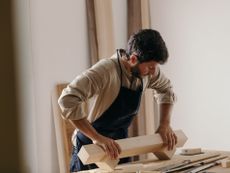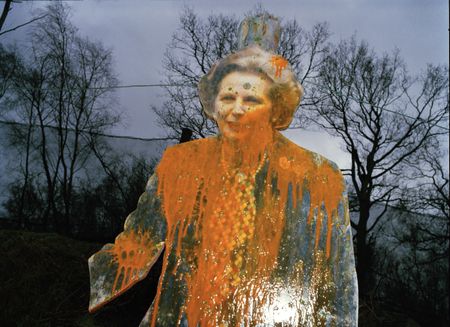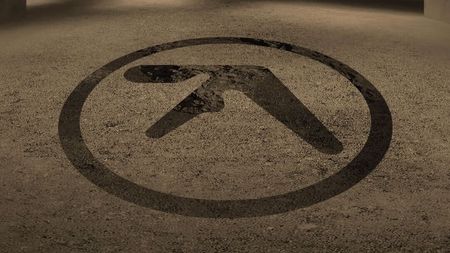At Glastonbury’s Shangri-La, activism and innovation meet
Glastonbury’s south-east corner is known for its after-dark entertainment but by day, there is a different story to tell

If you venture to the south-east corner of Glastonbury’s sprawling Worthy Farm site, you’ll find Shangri-La, a patch of field filled with tiny club venues, outdoor stages and political art. Each year, the area adopts a different theme but, for 2024, the concept picks up where last year left off with ‘Everything Must Go – The Sequel’, an immersive commentary on consumerism and capitalism.
As you walk through the area's central 'parade', structures made to look like shop fronts line the path. On one side, you’ll see people doing their make-up for phone cameras through the window of the InfluenceZoo and a boss berating their employee in the Fulfilment Centre. On the other, there’s Capitalism To Gogo, complete with staff pushing products on from bending the glass, and State Agents, a satirical take on a realtor’s office.
‘It’s a version of an alternative high street experience,’ says Kaye Dunnings, Shangri-La’s creative director. ‘Our high streets and communities are in decline and, looking at those things, late-stage capitalism is mostly the problem. It’s looking at solutions, but also trying to find ways to deal with the trauma through comedy.’
The shopping parade culminates in the new, alfresco Peace Stage, which will be present at the festival for this year only. The space is designed as a decaying shopping centre, the lettering on its signage crooked and unkempt. The space will change over the weekend as activists and artists – and general festival-goers – paste up art they’ve created on site, sharing their positive messages with those who enter the area. ‘We’re looking at consumerism, but twisting and turning it into something that makes us feel really good, positive and powerful,’ Dunnings explains of the ‘living, breathing piece of art’.

Shangri-La in 2024 is also opening its doors to communities that are often less commonly represented in mainstream culture. In the Nomad space, you can become a member of the Chapel Of Unrest, a protest group based in Bristol’s Rockaway Park, aiming to spread hope to their community and beyond. In a blue bus next door, you can join one of their number, Joe, for a cup of tea in the vehicle he calls home.
Next door, under a bright red sign, is Arrivals: a new live space and a Glastonbury first. Run by the team behind Dialled In, the events team and platform showcasing South Asian creativity, it will play host to artists and DJs from the diaspora all weekend. Inside, it transports punters to an alien jungle planet, its walls adorned with illustrations that connect imagery from the South Asian world with pulp sci-fi visuals.
‘Everything has a meaning and speaks to the past, present and future,’ Dhruva Balram of Dialled In says. ‘The space has been designed, conceptualised and programmed by an entirely South Asian team.’ It marks the first time that region has been represented so strongly at Glastonbury – proof that, even this far into its story, the festival continues to evolve and expand its reach, ever wider.
Wallpaper* Newsletter
Receive our daily digest of inspiration, escapism and design stories from around the world direct to your inbox.
Rhian Daly is a culture journalist who has contributed to the likes of Billboard, Rolling Stone, Grazia and more.
-
 Fluid workspaces: is the era of prescriptive office design over?
Fluid workspaces: is the era of prescriptive office design over?We discuss evolving workspaces and track the shape-shifting interiors of the 21st century. If options are what we’re after in office design, it looks like we’ve got them
By Ellie Stathaki Published
-
 This collection of slow furniture is a powerful ode to time
This collection of slow furniture is a powerful ode to timeA serene exhibition of David Dolcini's 'Time-made' collection has fast-tracked its place into our hearts and homes
By Ifeoluwa Adedeji Published
-
 Is the Pragma P1 the most sustainable watch yet?
Is the Pragma P1 the most sustainable watch yet?Geneva-based brand Pragma combines industrial design with real sustainable credentials
By Hannah Silver Published
-
 From counter-culture to Northern Soul, these photos chart an intimate history of working-class Britain
From counter-culture to Northern Soul, these photos chart an intimate history of working-class Britain‘After the End of History: British Working Class Photography 1989 – 2024’ is at Edinburgh gallery Stills
By Tianna Williams Published
-
 Stanley Donwood on decades of Glastonbury poster design
Stanley Donwood on decades of Glastonbury poster designWhile Glastonbury fans huff and puff over this year's line-up announcement, we talk to the man responsible for designing the festival’s poster, for the last two decades
By Craig McLean Published
-
 The Chemical Brothers’ Tom Rowlands on creating an electronic score for historical drama, Mussolini
The Chemical Brothers’ Tom Rowlands on creating an electronic score for historical drama, MussoliniTom Rowlands has composed ‘The Way Violence Should Be’ for Sky’s eight-part, Italian-language Mussolini: Son of the Century
By Craig McLean Published
-
 Surrealism as feminist resistance: artists against fascism in Leeds
Surrealism as feminist resistance: artists against fascism in Leeds‘The Traumatic Surreal’ at the Henry Moore Institute, unpacks the generational trauma left by Nazism for postwar women
By Katie Tobin Published
-
 From activism and capitalism to club culture and subculture, a new exhibition offers a snapshot of 1980s Britain
From activism and capitalism to club culture and subculture, a new exhibition offers a snapshot of 1980s BritainThe turbulence of a colourful decade, as seen through the lens of a diverse community of photographers, collectives and publications, is on show at Tate Britain until May 2025
By Anne Soward Published
-
 Tate Modern to host Aphex Twin listening experience
Tate Modern to host Aphex Twin listening experienceA free listening event for Aphex Twin's reissued album 'Selected Ambient Works II (Expanded Edition)' on the 25th of October
By Smilian Cibic Published
-
 Björk announces Cornucopia: The Book
Björk announces Cornucopia: The BookThe photographic documentation of Björk’s otherworldly tour
By Smilian Cibic Published
-
 'Anything I put out into the world, I want to be a prayer': musician Laura Marling on eschewing traditional merch for tarot-inspired prints
'Anything I put out into the world, I want to be a prayer': musician Laura Marling on eschewing traditional merch for tarot-inspired printsAs Laura Marling prepares to release her eighth album, 'Patterns in Repeat', Craig McLean learns about another artistic pursuit that occupies her time
By Craig McLean Published